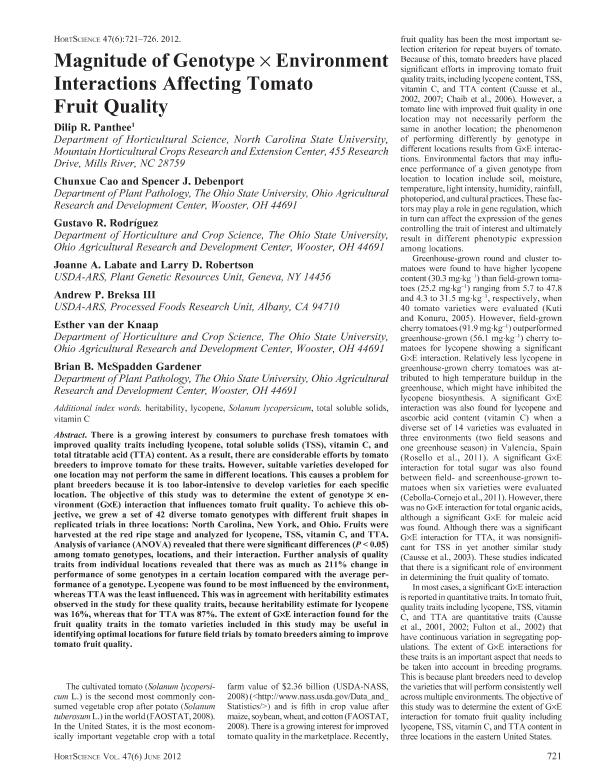Mostrar el registro sencillo del ítem
dc.contributor.author
Panthee, Dilip R.
dc.contributor.author
Cao, Chunxue
dc.contributor.author
Debenport, Spencer J.
dc.contributor.author
Rodríguez, Gustavo Rubén

dc.contributor.author
Labate, Joanne A.
dc.contributor.author
Robertson, Larry D.
dc.contributor.author
Breksa, Andrew P.
dc.contributor.author
van der Knaap, Esther
dc.contributor.author
McSpadden Gardener, Brian B.
dc.date.available
2019-02-01T15:43:04Z
dc.date.issued
2012-06
dc.identifier.citation
Panthee, Dilip R.; Cao, Chunxue; Debenport, Spencer J.; Rodríguez, Gustavo Rubén; Labate, Joanne A.; et al.; Magnitude of Genotype × Environment Interactions Affecting Tomato Fruit Quality; American Society for Horticultural Science; Hortscience; 47; 6; 6-2012; 721-726
dc.identifier.issn
0018-5345
dc.identifier.uri
http://hdl.handle.net/11336/69182
dc.description.abstract
There is a growing interest by consumers to purchase fresh tomatoes with improved quality traits including lycopene, total soluble solids (TSS), vitamin C, and total titratable acid (TTA) content. As a result, there are considerable efforts by tomato breeders to improve tomato for these traits. However, suitable varieties developed for one location may not perform the same in different locations. This causes a problem for plant breeders because it is too labor-intensive to develop varieties for each specific location. The objective of this study was to determine the extent of genotype x environment (GxE) interaction that influences tomato fruit quality. To achieve this objective, we grew a set of 42 diverse tomato genotypes with different fruit shapes in replicated trials in three locations: North Carolina, New York, and Ohio. Fruits were harvested at the red ripe stage and analyzed for lycopene, TSS, vitamin C, and TTA.Analysis of variance (ANOVA) revealed that there were significant differences (P < 0.05) among tomato genotypes, locations, and their interaction. Further analysis of quality traits from individual locations revealed that there was as much as 211% change in performance of some genotypes in a certain location compared with the average performance of a genotype. Lycopene was found to be most influenced by the environment, whereas TTA was the least influenced. This was in agreement with heritability estimates observed in the study for these quality traits, because heritability estimate for lycopene<br />was 16%, whereas that for TTA was 87%. The extent of G·E interaction found for fruit quality traits in the tomato varieties included in this study may be useful in identifying optimal locations for future field trials by tomato breeders aiming to improve tomato fruit quality.
dc.format
application/pdf
dc.language.iso
eng
dc.publisher
American Society for Horticultural Science

dc.rights
info:eu-repo/semantics/openAccess
dc.rights.uri
https://creativecommons.org/licenses/by-nc-sa/2.5/ar/
dc.subject
Heritability
dc.subject
Lycopene
dc.subject
Vitamin C
dc.subject
Solanum Lycopersicum
dc.subject
Total Soluble Solids
dc.subject.classification
Agricultura

dc.subject.classification
Agricultura, Silvicultura y Pesca

dc.subject.classification
CIENCIAS AGRÍCOLAS

dc.title
Magnitude of Genotype × Environment Interactions Affecting Tomato Fruit Quality
dc.type
info:eu-repo/semantics/article
dc.type
info:ar-repo/semantics/artículo
dc.type
info:eu-repo/semantics/publishedVersion
dc.date.updated
2019-02-01T14:00:09Z
dc.journal.volume
47
dc.journal.number
6
dc.journal.pagination
721-726
dc.journal.pais
Estados Unidos

dc.journal.ciudad
Maryland
dc.description.fil
Fil: Panthee, Dilip R.. North Carolina State University; Estados Unidos
dc.description.fil
Fil: Cao, Chunxue. Ohio State University; Estados Unidos
dc.description.fil
Fil: Debenport, Spencer J.. Ohio State University; Estados Unidos
dc.description.fil
Fil: Rodríguez, Gustavo Rubén. Ohio State University; Estados Unidos. Consejo Nacional de Investigaciones Científicas y Técnicas. Centro Científico Tecnológico Conicet - Rosario. Instituto de Investigaciones en Ciencias Agrarias de Rosario. Universidad Nacional de Rosario. Facultad de Ciencias Agrarias. Instituto de Investigaciones en Ciencias Agrarias de Rosario; Argentina. Consejo Nacional de Investigaciones Científicas y Técnicas. Centro Científico Tecnológico Conicet - Córdoba. Instituto de Humanidades. Universidad Nacional de Córdoba. Instituto de Humanidades; Argentina
dc.description.fil
Fil: Labate, Joanne A.. United States Department of Agriculture. Agricultural Research Service; Argentina
dc.description.fil
Fil: Robertson, Larry D.. United States Department of Agriculture. Agricultural Research Service; Argentina
dc.description.fil
Fil: Breksa, Andrew P.. United States Department of Agriculture. Agricultural Research Service; Argentina
dc.description.fil
Fil: van der Knaap, Esther. Ohio State University; Estados Unidos
dc.description.fil
Fil: McSpadden Gardener, Brian B.. Ohio State University; Estados Unidos
dc.journal.title
Hortscience

dc.relation.alternativeid
info:eu-repo/semantics/altIdentifier/doi/https://doi.org/10.21273/HORTSCI.47.6.721
dc.relation.alternativeid
info:eu-repo/semantics/altIdentifier/url/https://journals.ashs.org/hortsci/view/journals/hortsci/47/6/article-p721.xml
Archivos asociados
